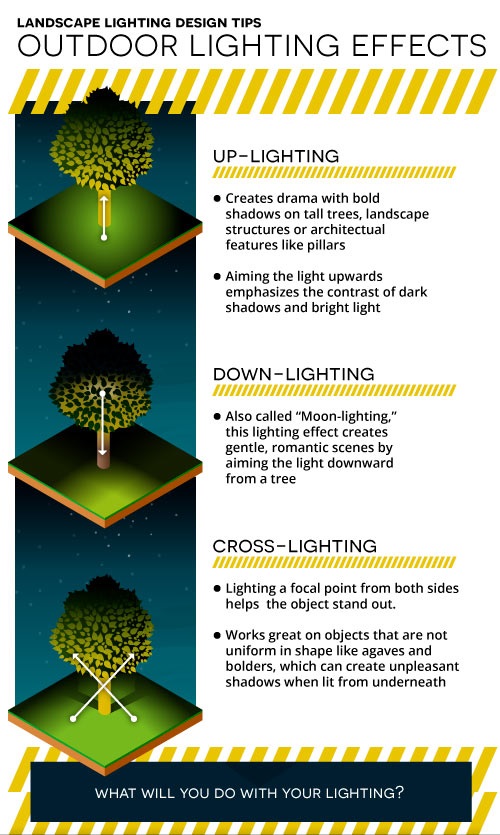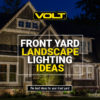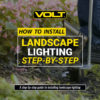The Approach of Landscape Lighting Design
 Plants and trees often take center stage when it comes to landscaping, but smart exterior lighting plays an equally important role. In addition to the obvious aesthetic benefits, landscape lighting can also increase the functionality of your outdoor spaces while improving the safety and security around your home.
Plants and trees often take center stage when it comes to landscaping, but smart exterior lighting plays an equally important role. In addition to the obvious aesthetic benefits, landscape lighting can also increase the functionality of your outdoor spaces while improving the safety and security around your home.
A well-planned and thoughtfully-executed outdoor lighting system enables you to create effects that accomplish the main goals of landscape lighting design:
- Safety – Outdoor lighting can add safety in a variety of ways. Walkways lights, for instance, can help your family and guests navigate around your property after dark. Lighting can also be used to illuminate other potential dangers, like stairs and drop-offs, making them less likely to cause injury at night.
- Security – A well-lit exterior can make your home less of a target for crimes like vandalism and burglary. When designing an outdoor lighting system, consider the darkest areas of the yard and places near the home where a burglar could enter.
- Functionality – Why should you only enjoy your outdoor living spaces during the day? With proper landscape lighting, you can continue to enjoy your front and backyard long after the sun goes down. Outdoor lights are particularly helpful when it comes to entertaining, since they extend the party outside and give guests more room to enjoy themselves.
- Beauty – Proper landscape lighting should evoke strong aesthetic and emotional responses. Positioned properly, landscape lighting can make key outdoor features stand out, such as statues, flag poles, centerpiece trees, and other focal landscape elements.
Satisfying all these goals may seem overwhelming, but there’s nothing wrong with taking a simple approach and focusing on one or two at a time. For example, you may decide to light the pathway leading to your front door. Your main goal is probably “safety” since you want the illumination to reveal the edges of the path and any irregularities that could cause tripping, but you also want to check the “beauty” column.
In this case, to satisfy safety and beauty is straightforward – just select path lights that have a good wide coverage, and that are (themselves) beautiful. In fact, without knowing it, you may be satisfying all or most of the other goals without even trying. This is especially the case when you select premium-quality landscape lights such as those from VOLT® Lighting.
If you are a determined do-it-yourselfer and wish to attempt a more in-depth approach to the design, don’t try to light your entire property at one time. Instead, separate your property into regions or zones.
Typical zones might be an entrance path, island garden bed, or backyard patio. Focus on just one zone and aim to illuminate it with all the goals in mind. Don’t start the second zone until you finish the first. You’ll find that your lighting design skill will improve with each zone you design and install.
You may also consider hiring an experienced lighting designer. These professionals spend many years mastering various techniques to produce beautiful and effective designs. Even though you love doing everything yourself, if you have the resources, hiring a pro is the surest way to end up with a great lighting design.
Landscape Lighting Design Tips
Outdoor lighting effects
 You know what you want to light, but how do you actually do it? There are three basic outdoor lighting effects that, when used together, create the layered and dramatic look characteristics of the best landscape lighting designs:
You know what you want to light, but how do you actually do it? There are three basic outdoor lighting effects that, when used together, create the layered and dramatic look characteristics of the best landscape lighting designs:
- Up-lighting – Use this effect to create drama with bold shadows on tall trees or landscape structures. Aiming the light upwards emphasizes the contrast of dark shadows and bright light. Up-lighting can also highlight architectural features around your home, such as columns.
- Down-lighting – Also referred to as moon-lighting, this lighting effect creates gentle, romantic light scenes by aiming light downward, usually from a tree. Down-lighting creates a particularly impressive effect when mounted on top of an open-branched tree.
- Cross-lighting – Lighting a focal point from both sides eliminates unwanted shadows and helps the object stand out. This effect works great for objects that are not uniform in shape, such as agaves and boulders, which can create unpleasant shadows when lit from a single source underneath or above.
Benefits of LED landscape lights
Whether you’re designing a new landscape lighting system from scratch, updating an existing system, or just adding a few new fixtures around the house, make sure you consider using LEDs. Some of the specific benefits of using LEDs for landscape lighting include:
- Smaller – LEDs are very small and thin compared to incandescent fixtures, making them easier to install in hard-to-reach locations around your home.
- Safer – LEDs are much cooler to the touch than incandescent bulbs, greatly reducing the risk of a fire starting if a branch or leaf is in contact with the lighting fixture.
- Durable – Because LEDs don’t have filaments, they can withstand external impacts that would smash any incandescent bulb.
- Efficient – LEDs consume 80-90% less energy than incandescent lights and have a projected lifespan up to nine times as long as a CFL (45 years vs. five years).






